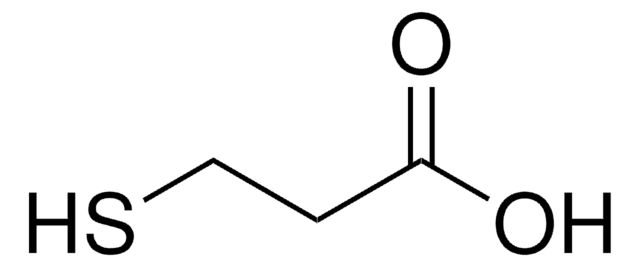725226
6-Mercapto-1-hexanol
99%
Synonym(s):
6-Hydroxy-1-hexanethiol, 6-MCH, 6-Mercaptohexan-1-ol, 6-Mercaptohexanol, MCH
Sign Into View Organizational & Contract Pricing
All Photos(2)
About This Item
Linear Formula:
HS(CH2)6OH
CAS Number:
Molecular Weight:
134.24
Beilstein:
1846871
MDL number:
UNSPSC Code:
12352300
PubChem Substance ID:
NACRES:
NA.23
Recommended Products
Assay
99%
form
liquid
refractive index
n20/D 1.486 (lit.)
bp
225 °C (lit.)
density
0.981 g/mL at 25 °C (lit.)
SMILES string
SCCCCCCO
InChI
1S/C6H14OS/c7-5-3-1-2-4-6-8/h7-8H,1-6H2
InChI key
UGZAJZLUKVKCBM-UHFFFAOYSA-N
Looking for similar products? Visit Product Comparison Guide
Related Categories
Application
This compound is used to produce hydrophilic SAMs. The resulting monolayers which are terminated with alcohols can be further functionalized with various groups even when attached to gold nanoclusters.
Signal Word
Warning
Hazard Statements
Precautionary Statements
Hazard Classifications
Eye Irrit. 2 - Skin Irrit. 2 - STOT SE 3
Target Organs
Respiratory system
Storage Class Code
10 - Combustible liquids
WGK
WGK 3
Flash Point(F)
>230.0 °F - closed cup
Flash Point(C)
> 110 °C - closed cup
Choose from one of the most recent versions:
Already Own This Product?
Find documentation for the products that you have recently purchased in the Document Library.
Customers Also Viewed
Hua Tan et al.
The journal of physical chemistry. B, 110(43), 21690-21693 (2006-10-27)
Au-MCH nanoclusters of (1.5 +/- 0.3) nm diameter (MCH = 6-mercapto-1-hexanol, HS-(CH2)6-OH) have been prepared and characterized by Transmission Electron Microscopy (TEM), UV-visible, Nuclear Magnetic Resonance (NMR), Fourier Transform Infrared (FTIR) absorption spectroscopies, X-ray Powder Diffraction (XRD), and Thermogravimetric Analysis
Andres Lombana et al.
Journal of peptide science : an official publication of the European Peptide Society, 20(7), 563-569 (2014-06-13)
Development of resistant bacteria onto biomaterials is a major problem leading to nosocomial infections. Antimicrobial peptides are good candidates for the generation of antimicrobial surfaces because of their broad-spectrum activity and their original mechanism of action (i.e. rapid lysis of
Wei Wen et al.
Biosensors & bioelectronics, 71, 13-17 (2015-04-17)
In this work, a sensitive exonuclease-assisted amplification electrochemical aptasensor through insertion approach was developed for the detection of mucin 1 (MUC 1). In order to construct the aptasensor, 6-Mercapto-1-hexanol (MCH) was used to block partial sites of gold electrode (GE)
Chapman, R. G.; et al.
Journal of the American Chemical Society, 122, 8303-8303 (2000)
Riccardo Funari et al.
Biosensors & bioelectronics, 169, 112578-112578 (2020-09-11)
The ongoing global pandemic of severe acute respiratory syndrome coronavirus 2 (SARS-CoV-2) has led to active research in its associated diagnostics and medical treatments. While quantitative reverse transcription polymerase chain reaction (qRT-PCR) is the most reliable method to detect viral
Our team of scientists has experience in all areas of research including Life Science, Material Science, Chemical Synthesis, Chromatography, Analytical and many others.
Contact Technical Service











